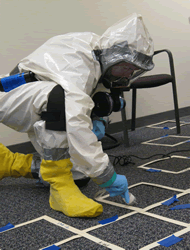ANTHRAX

Overview
Anthrax is an acute infectious disease caused by the spore-forming bacterium Bacillus anthracis (B. anthracis). B. anthracis spores are highly infective and can cause inhalation, cutaneous, or gastrointestinal anthrax. Inhalation anthrax results from breathing in spores and is of great concern due to its high fatality rate. Person-to-person spread is rare. (For more information see the CDC Anthrax Frequently Asked Questions .)
Anthrax infections occur naturally in wild and unvaccinated domestic animals in many countries including the U.S. Workers can be infected if they are exposed to infected animals or to meat or products (such as wool or hides) from infected animals.
Emergency response workers, including law enforcement, public health, and healthcare workers, are also at risk of exposure if B. anthracis is used as a biological weapon.
Anthrax Instructor Training Package
Naturally Occurring Anthrax
Workers may be exposed to B. anthracis if they work with infected animals or contaminated animal products or in environments contaminated by these products. Workers at risk include farmers, veterinarians, livestock handlers, diagnostic laboratory workers, and those who work with animal products.
Cutaneous anthrax infections may occur from skin contact with contaminated animal carcasses, wool, hides, or fur. Inhalation anthrax infections may occur from breathing in spores that may have been aerosolized either by processing or working with spore-contaminated animal products. Gastrointestinal anthrax may result from eating under-cooked meat from infected animals or from ingesting aerosolized spores.
Imported animal hides have recently been associated with a number of anthrax cases (cutaneous, inhalation, or gastrointestinal anthrax) in the U.S. Cases have occurred in drum makers using these hides. Cases have also occurred in people who have handled or been near the drums or in the environment where they were made.
Anthrax as a Biological Weapon
B. anthracis spores can be used as a biological weapon. The Centers for Disease Control and Prevention (CDC) classifies agents with recognized bioterrorism potential into three categories: A, B and C. Anthrax is classified as a Category A agent. One factor contributing to this classification is the ability of B. anthracis spores to persist in the environment for many years and the difficulty of inactivating them.
Category A agents are those that:
- pose the greatest possible threat for a major impact on public health
- may spread across a large area or need public awareness
- need a great deal of planning to protect the public’s health
B. anthracis is a select agent. The possession, use, or transfer of B. anthracis is regulated by the CDC Division of Select Agents and Toxins (DSAT), located in the CDC Office of Public Health Preparedness and Response.
Workers may be exposed to B. anthracis either during the initial terrorist attack or when responding to the emergency event. Emergency response workers, mail handlers (if B. anthracis is sent via the mail), decontamination workers, and critical infrastructure workers may be at risk of exposure to airborne or aerosolized spores during an emergency event, depending on the method of dissemination of the spores. In 2001 B. anthracis spores were intentionally distributed through the U.S. postal system, causing 22 anthrax cases. Eleven of the 22 cases were cutaneous and 11 were inhalation; 5 of the inhalation cases were fatal.
- Page last reviewed: August 16, 2013
- Page last updated: September 25, 2014
- Content source:
- National Institute for Occupational Safety and Health Emergency Preparedness and Response Office (EPRO)


 ShareCompartir
ShareCompartir
